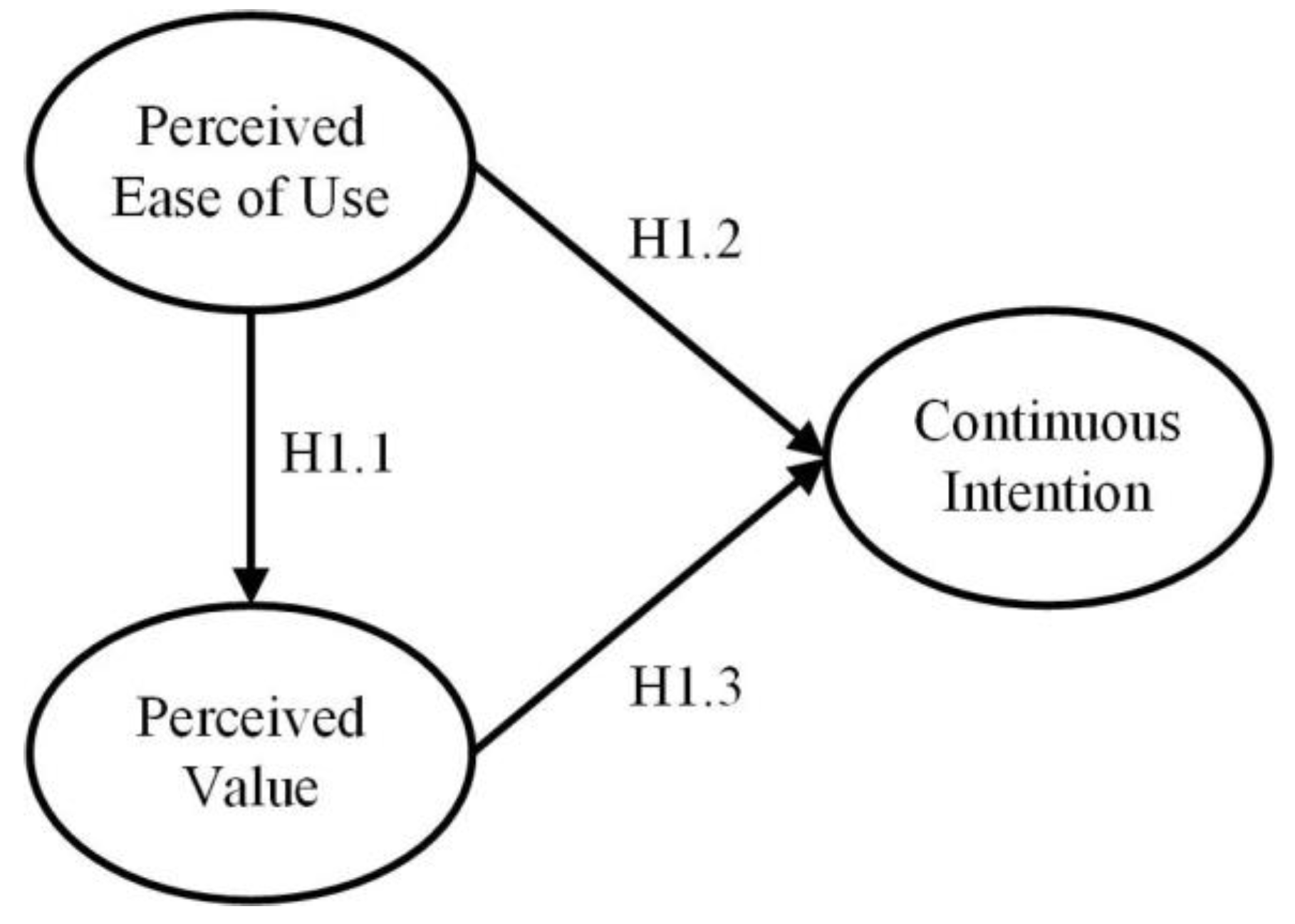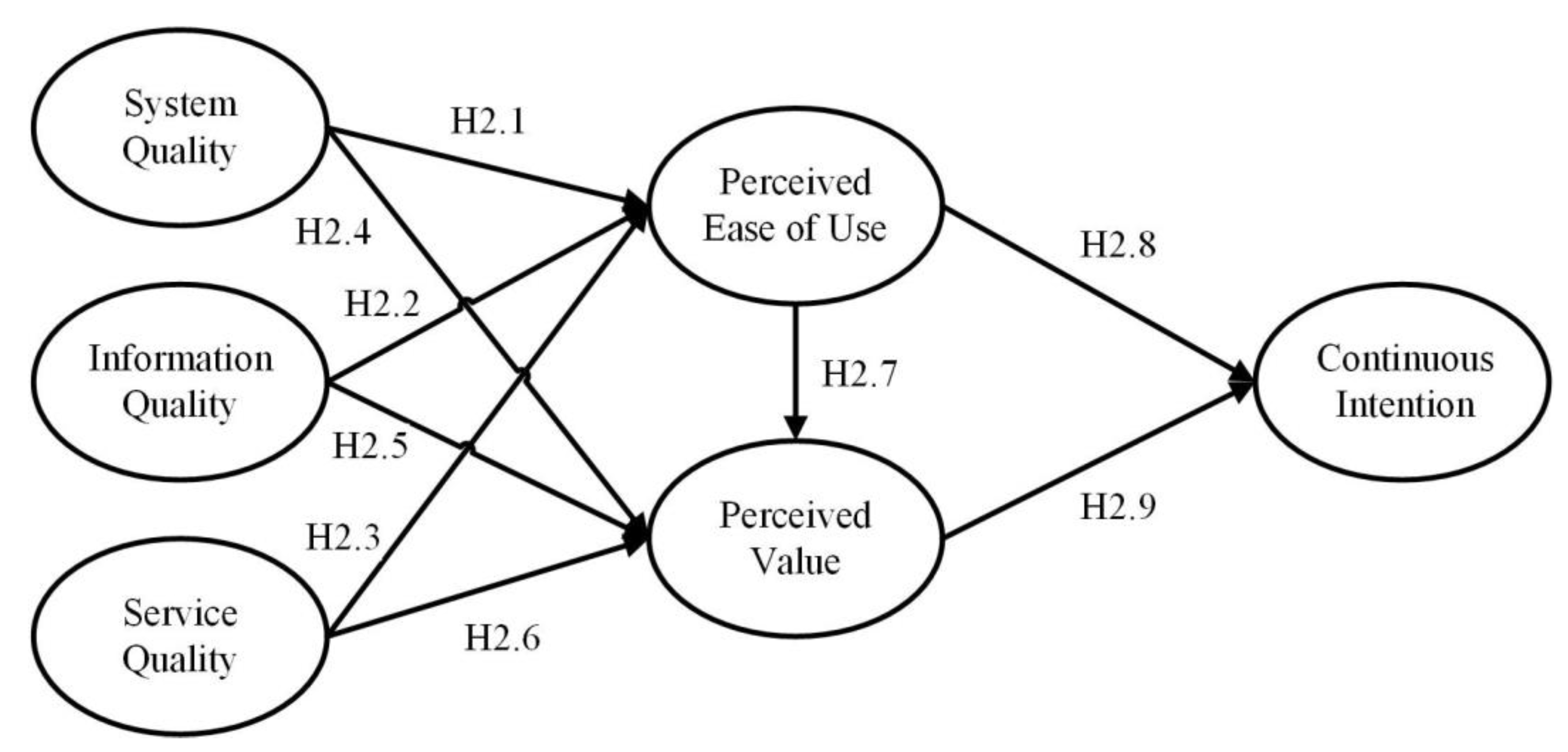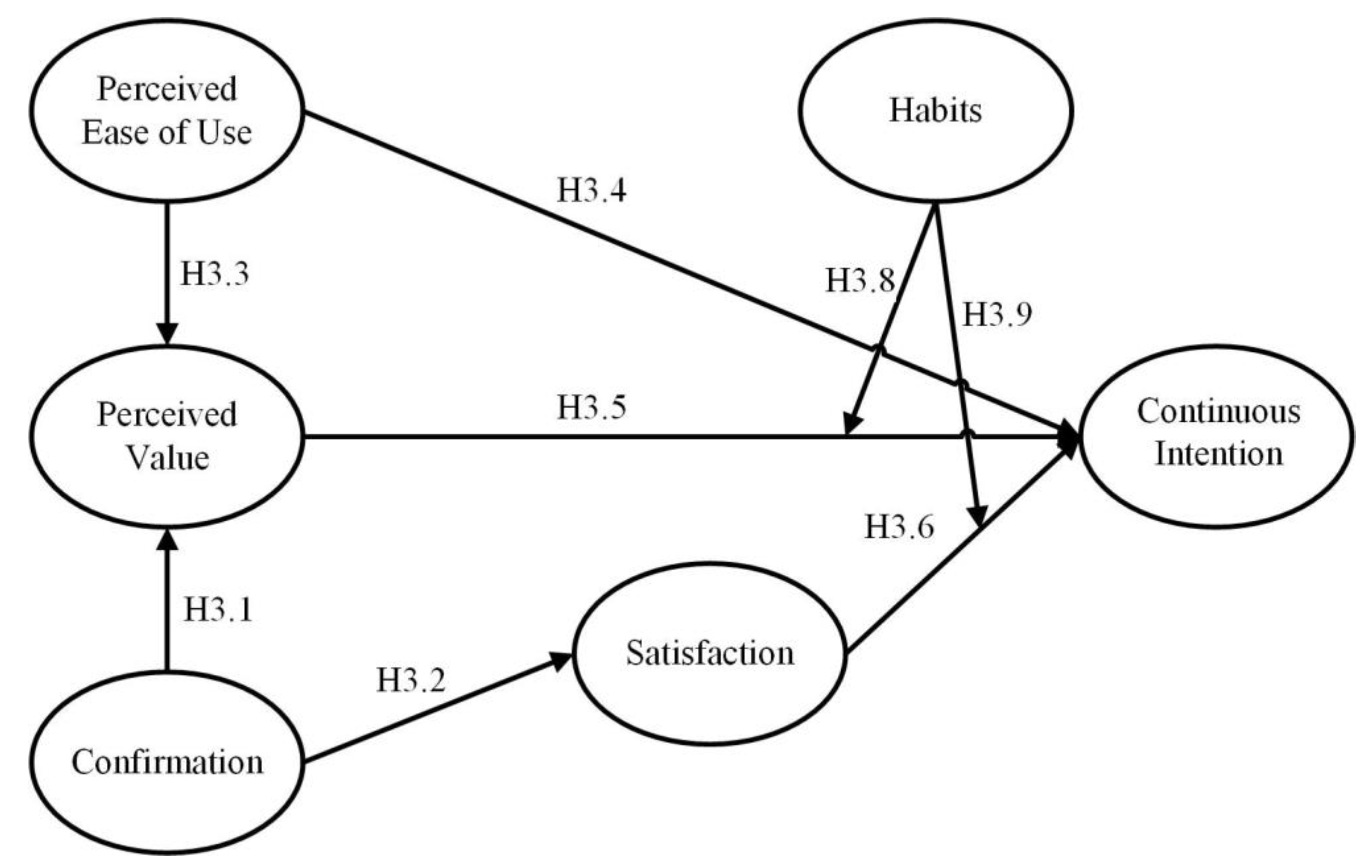Scientists believed the outbreak of COVID-19 could be linked to the consumption of wild animals, so food safety and hygiene have become the top concerns of the public. An agri-food traceability system becomes very important in this context because it can help the government to trace back the entire production and delivery process in case of food safety concerns. The traceability system is a complicated digitalized system because it integrates information and logistics systems. Previous studies used the technology acceptance model (TAM), information systems (IS) success model, expectation confirmation model (ECM), or extended model to explain the continuance intention of traceability system users.
- continuance intention
- traceability system
- technology acceptance model
- information systems success model
1. Introduction
2. Traceability System
3. Technology Acceptance Model (TAM)

4. TAM-IS Integrated Model

5. TAM-ECM Integrated Model

This entry is adapted from the peer-reviewed paper 10.3390/ijerph19031371
References
- Han, W.; Gu, Y.; Wang, W.; Zhang, Y.; Yin, Y.; Wang, J.; Zheng, L.R. The design of an electronic pedigree system for food safety. Inf. Syst. Front. 2015, 17, 275–287.
- Xiao, K.; Zhai, J.; Feng, Y.; Zhou, N.; Zhang, X.; Zou, J.J.; Shen, Y. Isolation of SARS-CoV-2-related coronavirus from Malayan pangolins. Nature 2020, 583, 286–289.
- Aung, M.M.; Chang, Y.S. Traceability in a food supply chain: Safety and quality perspectives. Food Control 2014, 39, 172–184.
- Ballin, N.Z.; Laursen, K.H. To target or not to target? Definitions and nomenclature for targeted versus non-targeted analytical food authentication. Trends Food Sci. Technol. 2019, 86, 537–543.
- Maitiniyazi, S.; Canavari, M. Exploring Chinese consumers’ attitudes toward traceable dairy products: A focus group study. J. Dairy Sci. 2020, 103, 11257–11267.
- Pelegrino, B.O.; Silva, R.; Guimarães, J.T.; Coutinho, N.F.; Pimentel, T.C.; Castro, B.G.; Freitas, M.Q.; Esmerino, E.A.; Sant’Ana, A.S.; Silva, M.C.; et al. Traceability: Perception and attitudes of artisanal cheese producers in Brazil. J. Dairy Sci. 2020, 103, 4874–4879.
- Fanelli, V.; Mascio, I.; Miazzi, M.M.; Savoia, M.A.; De Giovanni, C.; Montemurro, C. Molecular Approaches to Agri-Food Traceability and Authentication: An Updated Review. Foods 2021, 10, 1644.
- U.S. Food and Drug Administration. Food Safety and the Coronavirus Disease 2019 (COVID-19); U.S. Food and Drug Administration: Silver Spring, MD, USA, 2020.
- Hailu, G. Economic thoughts on COVID-19 for Canadian food processors. Can. J. Agric. Econ./Revue Can. d’Agroecon. 2020, 68, 163–169.
- McEwan, K.; Marchand, L.; Shang, M.; Bucknell, D. Potential implications of COVID-19 on the Canadian pork industry. Can. J. Agric. Econ./Revue Can. d’Agroecon. 2020, 68, 201–206.
- Nakat, Z.; Bou-Mitri, C. COVID-19 and the food industry: Readiness assessment. Food Control 2021, 121, 107661.
- Galanakis, C.M. The food systems in the era of the coronavirus (COVID-19) pandemic crisis. Foods 2020, 9, 523.
- Iftekhar, A.; Cui, X. Blockchain-Based Traceability System That Ensures Food Safety Measures to Protect Consumer Safety and COVID-19 Free Supply Chains. Foods 2021, 10, 1289.
- Liao, P.A.; Chang, H.H.; Chang, C.Y. Why is the food traceability system unsuccessful in Taiwan? Empirical evidence from a national survey of fruit and vegetable farmers. Food Policy 2011, 36, 686–693.
- FMRIC (Food Marketing Research and Information Center). Handbook for Introduction of Food Traceability System (Guidelines for Food Traceability). 2008. Available online: http://www.fmric.or.jp/trace/en/ (accessed on 5 September 2014).
- Golan, E.H.; Krissoff, B.; Kuchler, F.; Calvin, L.; Nelson, K.E.; Price, G.K. Traceability in the US Food Supply: Economic Theory and Industry Studies; No. 1473-2016-120760; United States Department of Agriculture (USDA): Washington, DC, USA, 2004.
- Chen, M.F.; Huang, C.H. The impacts of the food traceability system and consumer involvement on consumers’ purchase intentions toward fast foods. Food Control 2013, 33, 313–319.
- Buaprommee, N.; Polyorat, K. The antecedents of purchase intention of meat with traceability in Thai consumers. Asia Pac. Manag. Rev. 2016, 21, 161–169.
- Yuan, C.; Wang, S.; Yu, X. The impact of food traceability system on consumer perceived value and purchase intention in China. Ind. Manag. Data Syst. 2020, 120, 810–824.
- Davis, F.D. Perceived usefulness, perceived ease of use, and user acceptance of information technology. MIS Q. 1989, 13, 319–340.
- Zeithaml, V.A. Consumer perceptions of price, quality, and value: A means-end model and synthesis of evidence. J. Mark. 1988, 52, 2–22.
- DeLone, W.; McLean, E. Information systems success: The quest for the dependent variable. Inf. Syst. Res. 1992, 3, 60–95.
- DeLone, W.H.; McLean, E.R. Information systems success revisited. In Proceedings of the 35th Annual Hawaii International Conference on System Sciences, Big Island, HI, USA, 10 January 2002; pp. 2966–2976.
- DeLone, W.; McLean, E. The DeLone and McLean model of information systems success: A ten-year update. J. Manag. Inf. Syst. 2003, 19, 9–30.
- DeLone, W.H.; McLean, E.R. Measuring e-commerce success: Applying the DeLone & McLean information systems success model. Int. J. Electron. Commer. 2004, 9, 31–47.
- Mustapha, B.; Obid, S.N.B.S. Tax service quality: The mediating effect of perceived ease of use of the online tax system. Procedia-Soc. Behav. Sci. 2015, 172, 2–9.
- Bahari, K.A.; Abdullah, D.; Kamal, M.S.B.; Johari, N.R.; Zulkafli, M.S. The influence of hotel website design quality, perceived ease of use and perceived usefulness on loyalty intention. Turk. Online J. Des. Art Commun. 2018, 701–710.
- Li, Y.; Shang, H. Service quality, perceived value, and citizens’ continuous-use intention regarding e-government: Empirical evidence from China. Inf. Manag. 2020, 57, 103197.
- Ali, B.M.; Younes, B. The impact of information systems on user performance: An exploratory study. J. Knowl. Manag. Econ. Inf. Technol. 2013, 3, 128–154.
- Machdar, N.M. The effect of information quality on perceived usefulness and perceived ease of use. Bus. Entrep. Rev. 2019, 15, 131–146.
- Tsao, W.C.; Hsieh, M.T.; Lin, T.M. Intensifying online loyalty! The power of website quality and the perceived value of consumer/seller relationship. Ind. Manag. Data Syst. 2016, 116, 1987–2010.
- Putri, W.K.; Pujani, V. The influence of system quality, information quality, e-service quality and perceived value on Shopee consumer loyalty in Padang City. Int. Technol. Manag. Rev. 2019, 8, 10–15.
- Sarmento, A.; Mesquita, A. (Eds.) User Perception and Influencing Factors of Technology in Everyday Life; Information Science Reference; American Psychological Association: Washington, DC, USA, 2013; pp. 303–309.
- Khasawneh, M.H.A.; Haddad, N. Analysis of the effects of ease of use, enjoyment, perceived risk on perceived value and subsequent satisfaction created in the context of C2C online exchanges. Int. J. Electron. Mark. Retail. 2020, 11, 217–238.
- Jin, N.; Lee, S.; Lee, H. The effect of experience quality on perceived value, satisfaction, image and behavioral intention of water park patrons: New versus repeat visitors. Int. J. Tour. Res. 2015, 17, 82–95.
- Meng, S.M.; Liang, G.S.; Yang, S.H. The relationships of cruise image, perceived value, satisfaction, and post-purchase behavioral intention on Taiwanese tourists. Afr. J. Bus. Manag. 2011, 5, 19–29.
- Jen, W.; Tu, R.; Lu, T. Managing passenger behavioral intention: An integrated framework for service quality, satisfaction, perceived value, and switching barriers. Transportation 2011, 38, 321–342.
- Kamtarin, M. The effect of electronic word of mouth, trust and perceived value on behavioral intention from the perspective of consumers. Int. J. Acad. Res. Econ. Manag. Sci. 2012, 1, 56.
- Oliver, R.L. A cognitive model of the antecedents and consequences of satisfaction decisions. J. Mark. Res. 1980, 17, 460–469.
- Bhattacherjee, A. Understanding information systems continuance: An expectation-confirmation model. MIS Q. 2001, 25, 351–370.
- Cheng, Y.M. Investigating medical professionals’ continuance intention of the cloud-based e-learning system: An extension of expectation–confirmation model with flow theory. J. Enterp. Inf. Manag. 2020, 34, 1169–1202.
- Dai, H.M.; Teo, T.; Rappa, N.A.; Huang, F. Explaining Chinese university students’ continuance learning intention in the MOOC setting: A modified expectation confirmation model perspective. Comput. Educ. 2020, 150, 103850.
- Wang, T.; Lin, C.L.; Su, Y.S. Continuance Intention of University Students and Online Learning during the COVID-19 Pandemic: A Modified Expectation Confirmation Model Perspective. Sustainability 2021, 13, 4586.
- Jumaan, I.A.; Hashim, N.H.; Al-Ghazali, B.M. The role of cognitive absorption in predicting mobile internet users’ continuance intention: An extension of the expectation-confirmation model. Technol. Soc. 2020, 63, 101355.
- Wu, L.; Chiu, M.L.; Chen, K.W. Defining the determinants of online impulse buying through a shopping process of integrating perceived risk, expectation-confirmation model, and flow theory issues. Int. J. Inf. Manag. 2020, 52, 102099.
- Chiu, W.; Cho, H.; Chi, C.G. Consumers’ continuance intention to use fitness and health apps: An integration of the expectation–confirmation model and investment model. Inf. Technol. People 2020, 34, 978–998.
- Tam, C.; Santos, D.; Oliveira, T. Exploring the influential factors of continuance intention to use mobile Apps: Extending the expectation confirmation model. Inf. Syst. Front. 2020, 22, 243–257.
- Hsu, C.L.; Lin, J.C.C. What drives purchase intention for paid mobile apps?–An expectation confirmation model with perceived value. Electron. Commer. Res. App. 2015, 14, 46–57.
- Triandis, H.C. Dimensions of Cultural Variations as Parameters of Organizational Theories. Int. Stud. Manag. Organ. 1982, 12, 136–169.
- Khalifa, M.; Liu, V. Online consumer retention: Contingent effects of online shopping habit and online shopping experience. Eur. J. Inf. Syst. 2007, 16, 780–792.
- Limayem, M.; Cheung, C.M.K.; Chan, G. Explaining information systems adoption and post-adoption: Toward an integrative model. In Proceedings of the 24th International Conference on Information Systems, Seattle, WA, USA, 15–17 December 2003; pp. 720–731.
- Limayem, M.; Cheung, C.M. Understanding information systems continuance: The case of Internet-based learning technologies. Inf. Manag. 2008, 45, 227–232.
- Chiu, C.M.; Hsu, M.H.; Lai, H.; Chang, C.M. Re-examining the influence of trust on online repeat purchase intention: The moderating role of habit and its antecedents. Decis. Support Syst. 2012, 53, 835–845.
- Hsu, M.H.; Chang, C.M.; Chuang, L.W. Understanding the determinants of online repeat purchase intention and moderating role of habit: The case of online group-buying in Taiwan. Int. J. Inf. Manag. 2015, 35, 45–56.
- Anderson, R.E.; Srinivasan, S.S. E-satisfaction and e-loyalty: A contingency framework. Psychol. Mark. 2003, 20, 123–138.
